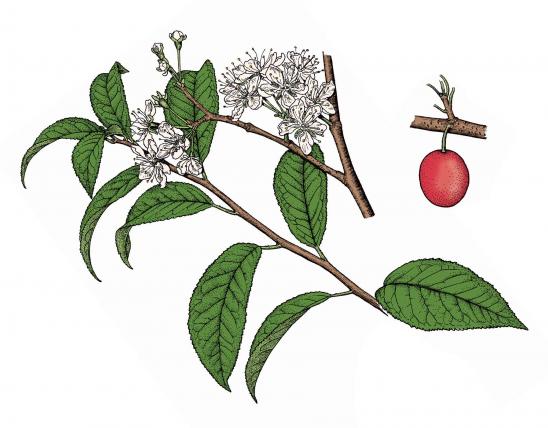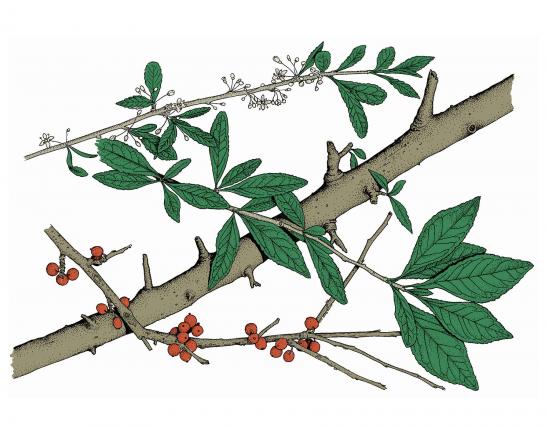
Prairie crab apple is a large shrub to small tree with low, crooked branches; thicket forming from suckers.
Leaves are alternate, simple, 1½–5 inches long, ¾–4 inches wide, variable; egg-shaped to widest in the middle and tapering at both ends, margin with shallow lobes, toothed; upper surface dark green, shiny, smooth; lower surface pale with white, densely matted hairs.
Bark is thin, reddish-brown to gray, grooves shallow, scales narrow and persistent.
Twigs are reddish-brown to gray, with densely matted hairs early; pores small and pale; twigs often with short lateral shoots or spurs, some spurs ending in a thorn.
Flowers April–May. Fragrant clusters of 2–5 flowers; flower stalks very hairy; petals 5, white or pink; cuplike green receptacle at the base of the petals densely hairy; stamens numerous.
Fruits August–September. Fleshy, applelike, about ¾–1¼ inches long, ¾–1½ inches wide, globe-shaped, greenish to yellow, sometimes with tiny yellow dots; surface waxy, greasy; pulp bitter, sour.
Similar species: Seven members of Malus (the apple genus) have been recorded growing out of cultivation (either native or naturalized) in Missouri. Prairie crab apple is most closely related to M. angustifolia (narrow-leaved crab apple) and M. coronaria (sweet crab apple), and these three native "wild crabs" might actually be the same species. In all three, the key characteristics separating them from other apples and crab apples are
- shallow lobes on the largest leaves (not unlobed),
- irregularly and sharply toothed margins (not finely and evenly toothed),
- pink to red (not yellow) anthers,
- leaves folded lengthwise (not curled inward) during development, and
- at least some of the branchlets bearing thorns.
A fourth species, the introduced toringo crab (M. sieboldii) shares the above characteristics, too, but it is uncommon, known only from the St. Louis area in ditches, old homesites, and disturbed areas, where it has persisted after cultivation. Though its flower base (calyx) is also densely hairy like prairie crab apple's, the calyx falls off before fruits develop, and its fruits are less than ½ inch long.
Height: to 20 feet; thicket-forming.

Statewide.
Habitat and Conservation
This conspicuous and attractive native species occurs in prairies, open woods, thickets, along streams, in borders of woods, and in pastures. Its deep rootstocks makes it difficult to transplant, but it can easily be propagated from seeds for ornamental use. In fall, the leaves turn a dull rose color blended with yellow and dull green. A variety called Bechtel's crab apple (f. plena) is double-flowering and is often planted in parks and gardens. A hybrid of prairie crab apple and cultivated apple (M. domestica) is called Soulard crab (M. xsoulardii); it has larger fruit than its crab apple parent. The fruit is too tart to be eaten raw but can be used in baking and in preserves.
Human Connections
An attractive ornamental tree whose hard, bitter fruits can nevertheless be used in making tasty jellies, cider, and vinegar.
Ecosystem Connections
The fruit is eaten by at least 20 species of birds and mammals, including bobwhite, ruffed grouse, foxes, skunks, opossums, raccoons, rabbits, woodchucks, squirrels, and deer. Songbirds use the dense thickets for cover.





























